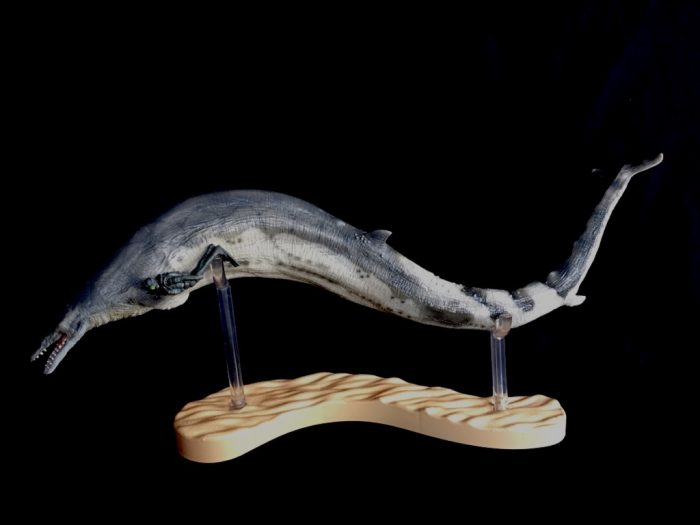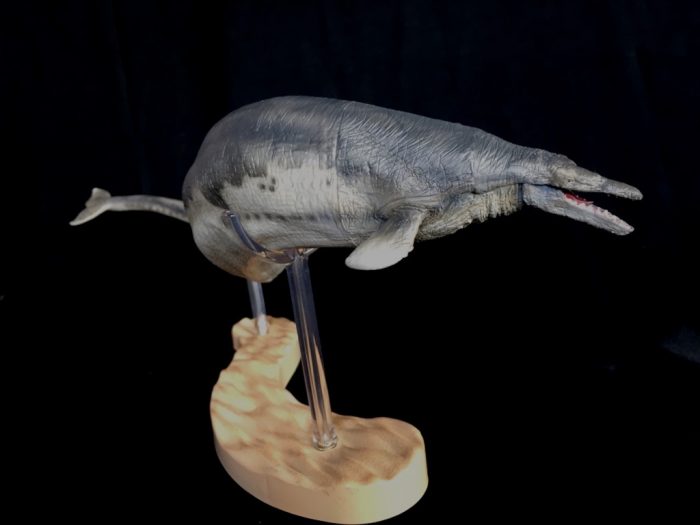Review and photos by Bokisaurus, edited by Suspsy
Many millions of years ago, the vast Tethys Sea covered what would one day be the deserts of the Middle East and other large parts of the world. The demise of the mighty aquatic marine reptiles, along with the dinosaurs at the end of the Cretaceous opened up these vast oceans for a new cast of characters to take center stage and dominate. Some 40 million years ago in the Late Eocene, a new giant marine superpredator had emerged: Basilosaurus. Dominating what was once the realm of mosasaurs and plesiosaurs, it quickly established itself as the king of the oceans. Superficially, Basilosaurus would easily be mistaken for a marine reptile. In fact, its name means “king lizard” since the first fossils discovered were believed to belong to some type of marine reptile. However, Basilosaurus is actually a mammal, a whale to be precise.

The size estimates for Basilosaurus is range anywhere from 60-70 feet(18-20 meters) long. There are two species currently known. B. cetoides is the larger of the two and has only been found in North America (both the states of Alabama and Mississippi have claimed it as their state fossil). B. isis is slightly smaller and has been found in both Egypt and Jordan. Eventually, the cooling of the Earth at the end of the Eocene disputed ocean currents and lead to the extinction of both Basilosaurus species and most other ancient whales.

Each year on the Dinosaur Toy Forum, we collectors of dinosaur and prehistoric animal figures share our wish lists of species we would love to see be made into figures. For many years, Basilosaurus was among those desired species, and despite rumours and speculation that a company would finally releasing one, it came to nothing when all the companies finally released their lists of new figures. Well, the wait is finally over! This year, the new Chinese company PNSO has finally granted all those wishes with their new Basilosaurus figure, the subject of today’s review.

And what a beauty it is! To start, this figure is huge, measuring in at 20 inches from the tip of the mouth to the tip of the tail. The figure comes in an elegant and beautifully designed box. Inside there is also a booklet with some beautiful illustrations. Unfortunately, all the informative text is in Chinese. The figure also comes with a beautifully sculpted stand. The base is designed to look like a sandy ocean floor complete with ripples in the sand. There are two Y-shaped acrylic rods that screw into the base. These two support the figure. The Basilosaurus is very well-sculpted and pretty much true to what this prehistoric whale may have looked like in the flesh. Unlike any other whale, it had an elongated, eel-like body form and this is faithfully depicted in the figure. The body is appropriately long, and depending on how you view the figure, forms an elegant S-shape. Right after the head, the huge body slowly slims down until it reaches the fluked tail.

The head is appropriately small when compared to the rest of the body. The sculpting is truly impressive. The shape of the head and jaws match up pretty well with the fossil records. Each of the massive teeth are individually sculpted. Inside the mouth, you can see the tongue, which is also sculpted separately and is slightly raised.
Unlike with so many figures, the paint job on the individual teeth, tongue, and inside of the mouth is perfectly done with no messy paint applications. The lower jaw is articulated so you can have a choice of an open mouth or a closed one. The articulation is nicely done and the seams are almost invisible.

Basilosaurus, like all whales, was descended from terrestrial mammals like Pakicetus. Its front flippers still had elbow joints and it had greatly reduced hind flippers where the hind legs would have been on its ancestors. Both of these features are nicely represented in this figure. The tail fluke is shaped just like those of modern whales. The sculptors also opted to give this figure a dorsal fin.

In addition, there are also four smaller bumps running along the top of the tail. I’m not sure what they are supposed to be. The skin is textured almost like an elephant’s skin and not the smooth skin one sees on modern whales and dolphins. I personally like the effect. Also, there are what appears to be parasitic barnacles all over the body, a nice touch in my opinion.

The colouration is best described as mottled with a combination of gray, white, brown, and black—all in various shades. The upper half of the body is dark gray, while the under is creamy white, typical of oceanic animals. They have done a really good job with the colour scheme. If you look closely, you can see the multiple layers of paint application on this figure. Simply amazing.

The figure is hollow, making it very light for its size. And like the rest of PNSO’s large figures, this one is also made up of various parts, a total of three, all glued together. The seams where these parts attach are still visible, but it’s not that bad. Again, the multiple layers of paint helped make them less visible.

In closing, I highly recommend this Basilosaurus. It is truly a work of art. The base for displaying the figure is elegant and makes this figure look more like a resin model than a plastic figure. The figure is durable enough to be considered a toy, but looks beautiful and well crafted to be a centerpiece display in any collection.
Disclaimer: links to Ebay and Amazon on the DinoToyBlog are affiliate links, so we make a small commission if you use them. Thanks for supporting us!





Caveat: I do not own this figure, but have purchased two others: Huanghetitan and Shantungosaurus. Both are relatively large breathtaking sculptures–however those damn visible joints detract horribly from the overall work; and the paint application on the former left something to be desired, namely there is a bare spot on the front of the face in which the white PVC is completely revealed.
To answer Arrancon’s question, both are approximately 1/40 scale, making the former 27″ long and the latter about 15″ (with the tail tip curled.)
Pity they couldn’t change the name; ‘Zeuglodon’ sounds so much cooler!
What a beautiful figure! I’ll have to get this–20″ long is a real treat, too.
Some whales have small bumps along the back of the tail, notably grays, humpbacks, & sperm whales. I assume the ones on this Basilosaurus are meant to be homologous.
I’ve seen this guy on Amazon, and I’m so tempted to buy it! Only question is: Would this be roughly 1:40 scale?